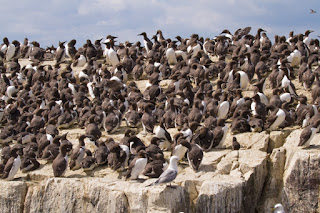Guillemots
Ever since then it has been our intention to visit another seabird colony with Skomer Island and the Farne Islands at the top of our list. However, crossing to offshore islands to see breeding seabirds isn’t entirely straightforward, particularly if your starting point is in Portugal! We needed to find an opportunity during what is always a busy time of the year and then we needed some settled weather for the boat crossing.
Atlantic Puffins - very cute!
Finally, this year, we made it. After just a few days back in the UK we headed north to Northumberland and the Farnes. Located just off the coast near Bamburgh, the Farnes are well-known as the home of thousands of breeding seabirds and were featured recently on the BBC Springwatch programme, so they need little introduction from us.
Arctic Tern
We spent just three days in Northumberland visiting Holy Island as well as the Farnes. Our trip to the Farnes was on a boat from Seahouses operated by Billy Shiel. We landed on Staple Island and on Inner Farne and had a little over two hours on each.
Bamburgh Castle - we stayed nearby
Seahouses harbour
Puffins (about 40,000 pairs) and Arctic Terns (about 2,000 pairs) are probably the main attractions but in recent years there has been a big increase in the number of Guillemots with more than 50,000 individuals counted. What a nightmare it must be counting that lot - we have difficulty counting just two or three thousand birds at Castro Marim! In all, about two dozen species nest on the islands, a total that includes several passerines.
Grey Seal - one of the many hundreds
Guillemot - numbers have increased dramatically in recent years
Northern Fulmar - Found only on St Kilda until the 1900s, now 500,000 pairs nest around the British coast
European Shag - the name apparently means 'tufted'
Rock Pipit feeding young
Common Shelduck - just a pair or two breed
Razorbill - one of the world's less numerous auk species
Settled weather and a healthy supply of food are the two important factors that lead to breeding success and from all the signs the auks were doing well. All three species were bringing in plenty of their staple diet of sandeels. Arctic Terns, on the other hand, were having a more difficult time finding food, we were told. What the eventual outcome of the season will be only time will tell.
Atlantic Puffin with sandeels
Arctic Tern - the longest of long-distance migrants
Eider Duck - about 600 pairs breed
Black-legged Kittiwake - said to be the world's most numerous gull species
Red Squirrel - not on the islands but not far from Bamburgh






















No comments:
Post a Comment